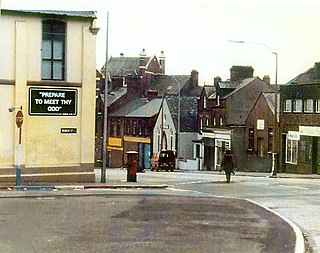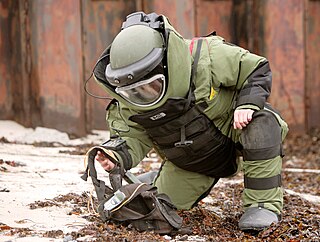Related Research Articles

Bomb disposal is an explosives engineering profession using the process by which hazardous explosive devices are disabled or otherwise rendered safe. Bomb disposal is an all-encompassing term to describe the separate, but interrelated functions in the military fields of explosive ordnance disposal (EOD) and improvised explosive device disposal (IEDD), and the public safety roles of public safety bomb disposal (PSBD) and the bomb squad.

Yahalom is a sayeret unit of the Israeli Combat Engineering Corps of the Israel Defense Forces (IDF).

The Explosive Ordnance Disposal Badge is a military badge of the United States Armed Forces which recognizes those service members, qualified as explosive ordnance disposal (EOD) technicians, who are specially trained to deal with the construction, deployment, disarmament, and disposal of high explosive munitions including other types of ordnance such as nuclear, biological and chemical weapons along with improvised explosive devices (IED) and improvised nuclear devices (IND). Also known as the “EOD Badge” or "Crab", the decoration is issued by the United States Army, Air Force, Navy and Marine Corps. The EOD Badge is the only occupational badge awarded to all five services under the United States Department of Defense.

United States Navy Explosive Ordnance Disposal technicians render safe all types of ordnance, including improvised, chemical, biological, and nuclear. They perform land and underwater location, identification, render-safe, and recovery of foreign and domestic ordnance. They conduct demolition of hazardous munitions, pyrotechnics, and retrograde explosives using detonation and burning techniques. They forward deploy and fully integrate with the various Combatant Commanders, Special Operations Forces (SOF), and various warfare units within the Navy, Marine Corps, Air Force and Army. They are also called upon to support military and civilian law enforcement agencies, as well as the Secret Service.

The Picatinny Arsenal is an American military research and manufacturing facility located on 6,400 acres (26 km2) of land in Jefferson and Rockaway Township in Morris County, New Jersey, United States, encompassing Picatinny Lake and Lake Denmark. The Arsenal is the headquarters of the US Army Combat Capabilities Development Command Armaments Center. It is known for developing the ubiquitous Picatinny rail, as well as being the Army's center of expertise for small arms cartridge ammunition.

The United States Army Ordnance Corps, formerly the United States Army Ordnance Department, is a sustainment branch of the United States Army, headquartered at Fort Gregg-Adams, Virginia. The broad mission of the Ordnance Corps is to supply Army combat units with weapons and ammunition, including at times their procurement and maintenance. Along with the Quartermaster Corps and Transportation Corps, it forms a critical component of the U.S. Army logistics system.
An ammunition technician (AT) is a British Army soldier, formerly of the Royal Army Ordnance Corps but since 1993 of the Royal Logistic Corps, trained to inspect, repair, test, store, and modify all ammunition, guided missiles, and explosives used by the British Army. These technicians are also trained to use demolition to safely dispose of individual items of ammunition and explosives (EODs) or to conduct logistics disposal of bulk stocks of multi items. After gaining sufficient experience, those who show the appropriate qualities are given extra training to render safe improvised explosive devices (IEDs) by a process called improvised explosive device disposal. Experienced ATs may be called to give evidence as expert witnesses in criminal or coroner's courts in relation to ammunition or explosives or to EOD and IEDD duties.

An ammunition technical officer (ATO) is an officer involved in all aspects of the army, air force, and navy's use of ammunition. This includes: bomb disposal, clearance of ERW, explosives accident investigation, procurement, in service management, storage, and inspection and repair.

The Royal Australian Army Ordnance Corps (RAAOC) is the Corps within the Australian Army concerned with supply and administration, as well as the demolition and disposal of explosives and salvage of battle-damaged equipment. The Corps contains clerks, operator supplies, petroleum operators, parachute riggers and ammunition technicians. Members of the Corps are nicknamed Roaches.
11 Explosive Ordnance Disposal and Search Regiment RLC is a specialist regiment of the British Army's Royal Logistic Corps (RLC) responsible for counter terrorist Explosive Ordnance Disposal (EOD), the safe recovery or disposal of conventional munitions. The regiment also has an ammunition inspectorate role supporting the Inspector Explosives (Army). With headquarters in Didcot, the regiment has sub units geographically based throughout the UK to provide a nationwide high readiness response capability in support of the police.

The Wheelbarrow is a remotely controlled robot designed in 1972 for use by British Army bomb disposal teams operating in Northern Ireland, mainland Britain and Iraq. Over 400 have been destroyed in operation, possibly saving the lives of their human counterparts.

A bomb suit, Explosive Ordnance Disposal (EOD) suit or a blast suit is a heavy suit of body armor designed to withstand the pressure generated by a bomb and any fragments the bomb may produce. It is usually worn by trained personnel attempting bomb disposal. In contrast to ballistic body armors, which usually focus on protecting the torso and head, a bomb suit must protect all parts of the body, since the dangers posed by a bomb's explosion affect the entire body.
The Naval Explosive Ordnance Disposal Technology Division (NAVEODTECHDIV) is a field activity of the United States Naval Sea Systems Command (NAVSEA). It is located 30 miles South of Washington, D.C. in Charles County, Maryland. NAVEODTECHDIV is a unique support activity administered by the U.S. Navy and utilized by all the Armed Services who work together to determine Joint Explosive Ordnance Disposal (EOD) requirements.

The Medium Mine Protected Vehicle (MMPV) is a class of armored vehicles being procured by the US Army, similar to the MRAP program, which is being pursued by the US Army and the US Marine Corps. The Army's MMPV executive summary states: "The Medium Mine Protected Vehicle (MMPV) is a blast protected, wheeled vehicle platform that will operate in explosive hazardous environments to support emerging Future Engineer Force (FEF) Clearance Companies in route and area clearance operations, Explosive Hazards Teams in explosive hazards reconnaissance operations, and EOD companies in Explosive Ordnance Disposal operations." According to a US Army spokesperson: "What separates these programs are different schedules and sustainment requirements, resulting in different acquisition strategies and source selection criteria priorities. The MMPV... and MRAP have been in close coordination, especially from a hardware perspective."

The 52nd Ordnance Group (EOD) is the command and control headquarters for all U.S. Army Explosive Ordnance Disposal (EOD) Battalions and Companies located east of the Mississippi River in the Continental United States (CONUS). The current command team consists of Colonel Matthew L. Kuhns and Command Sergeant Major Isaac J. Allender. Their command covers 184th and 192nd Ordnance Battalion (EOD), as well as the 63rd Chemical Company (CBRN). Subordinate units maintain EOD Response Teams, which evaluate, render safe, and remove conventional, chemical/biological, or nuclear ordnance, or improvised explosive devices (IEDs) which pose an immediate threat to public safety. While subordinate units are trained and equipped for combat operations, they may also support a variety of peacetime missions, to include range surface clearance operations of active U.S. Army installations, EOD and UXO operations in support of civilian law enforcement agencies, and support to the U.S. Secret Service for protection of VIPs.
The Kosovo Police's Bomb Squad (IED/EOD) was established in March 2006, prompted by the necessity to protect citizens’ lives and property, and to assist in investigation of crime-related cases.

The Ordnance Corps (ORD) is a combat support corps of the Irish Army, a branch of the Defence Forces, that has logistical and operational responsibility for military ordnance in Ireland. The logistical role of the Army Ordnance Corps is to provide technical support to the Defence Forces for the procurement, storage, distribution, inspection, maintenance, repair and disposal of all items of ordnance equipment. The operational role of the Ordnance Corps is to train personnel for and provide the state's bomb disposal capability.

No. 5131 (BD) Squadron was an Explosive Ordnance Disposal (EOD) squadron of the Royal Air Force. First formed in 1943, 5131 Bomb Disposal Squadron was the Royal Air Force’s explosive ordnance disposal capability for 77 years. Its technicians were trained to deal with conventional munitions, chemical munitions and improvised explosive devices. The Squadron also responded to aircraft crashes; clearing the area of explosive risks and making any ordnance, aircraft assisted escape systems and flare countermeasures safe. During the 77-year operational history of the squadron, it saw action in World War II, the Suez conflict, the Indonesian conflict, the Cyprus invasion, the Falkland Islands war, Kosovo, Bosnia, Iraq, Afghanistan and Northern Ireland as well as Military Assistance to Police taskings in the UK.

Technician Specialist in Deactivation of Explosive Artifacts, commonly known by its abbreviation TEDAX, is the Spanish name for bomb disposal units.

The 29 Group, formerly 29 Engineer Brigade, is an engineer formation of the British Army responsible for Explosive Ordnance Disposal and Search. Its headquarters were at Aldershot, now at Didcot.
References
- 1 2 "Alan Richwald Obituary 2022". Gasch's Funeral Home, P.A.
- 1 2 3 4 "Mr. Alan Richwald, Ordnance Corps Hall of Fame Inductee 2018, U.S. Army Ordnance Corps". goordnance.army.mil.
- 1 2 3 4 "EOD Disassembly and Robotics Complex" dedication plaque. 7 July 2023. U.S. Army Combat Capabilities Development Command, Picatinny Arsenal.
- 1 2 3 4 Medals, Samuel J. Heyman Service to America. "Alan Richwald". Samuel J. Heyman Service to America Medals.
- ↑ Commercial Construction & Renovation, Issue 10, 2023, pp. 111-114, https://issuu.com/bocdesigninc/docs/ccr-issue.10_3e2e14b4975122
- ↑ "US Patent for MK38 small caliber dearmer aiming device Patent (Patent # 7,047,862 issued May 23, 2006) - Justia Patents Search". patents.justia.com.
- ↑ https://alu.army.mil/alog/2011/novdec11/PDF/The%20Ordnance%20Order%20of%20Samuel%20Sharpe.pdf
- ↑ "US Patent for Secure disrupter unit for explosive ordnance disposal operations Patent (Patent # 9,347,728 issued May 24, 2016) - Justia Patents Search". patents.justia.com.
- ↑ "US Patent for Breech plug for disrupter unit Patent (Patent # D 749,183 issued February 9, 2016) - Justia Patents Search". patents.justia.com.
- ↑ "Keeper of the Flame".